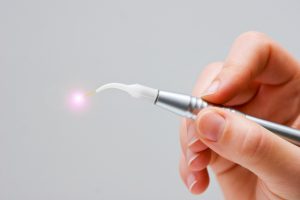
As a hygienist, one of my main duties is to provide non-surgical therapy for the treatment of periodontal disease. The goal, (during the non-surgical treatment approach), is to change the environment of the pocket, address the active infection and keep the patient in remission as long as possible. Meticulous removal of sub-gingival calculus with hand instruments and micro-ultrasonics is crucial. We must provide a biologically acceptable root surface.
In addition to detoxifying the root surfaces, we must deal with the bacteria that have invaded and are reproducing in the gingiva. The dental laser is the perfect technology to greatly reduce these tissue invasive pathogens*. By performing a MyPerioPath®, you will have objective evidence if these invasive bacteria are present and if a laser is warranted.
The word LASER is an acronym for LIGHT AMPLIFICATION by STIMULATED EMISSION OF RADIATION. The light energy kills pathogens in the pocket and sub-gingival tissue. A fiber optic tip is inserted into the pocket is aimed at the tissue. The laser beam penetrates the tissue, killing pathogens and providing bio-stimulation of the mitochondria in the cells. This is accomplished with a “cold” laser on a pulsed wave setting. No anesthetic is required for decontamination. The patient feels slight warmth and the movement of the tip, which is comparable to sweeping the pocket with a perio probe.
In states that allow hygienists to use a “hot,” or initiated, laser tip, we can selectively remove diseased tissue. A continuous wave setting is used and carbon is placed on the tip to create heat. Local or topical anesthetic must be used. The tip is kept moving multi-directionally to treat the entire sulcular surface. When appropriate wattage settings are used, the beam will only interact with diseased tissue. Commonly used dental lasers such as a diode or NdYAG are specific for pigments, so the beam is attracted to bleeding tissue. If the setting is too high, excessive tissue will be removed. This is why hands-on laser training with actual patients is best and laser safety training is required.
Although there is controversy in the literature as to the effectiveness of lasers for treating periodontal disease, clinicians who use a laser report improved healing with bleeding and pocket depth reduction, compared to treatments without the use of a laser. Post-operative discomfort is also reduced as the laser seals lymphatics and blood vessels, delaying and therefore lessening the body’s inflammatory response. Patients are reported to remain in remission longer after treatment with a laser.
State of the art technologies, like the laser and salivary diagnostics have allowed us to achieve our goal, a biologically acceptable root surface. I can’t wait to see what technology is next to help better care.
*Periodontology 2000, Vol. 28, 2002, 106-176; Jorgen Slots, Miriam Ting
For more information on how to become an OralDNA Provider – scan HERE: 
- StellaLife®: Technology Advances in Antimicrobial Rinse - September 18, 2020
- JP Institute TRANSFORMED! — My New Life As A Hygienist - August 17, 2018
- Salivary Diagnostics, Lasers and Beyond… - January 12, 2018
